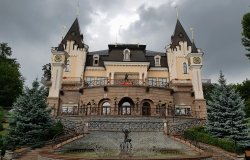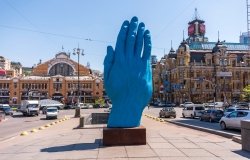
A blog of the Kennan Institute
Chernihiv Artist Reporting War Atrocities on TikTok

Shutterstock/MAKSYM CHUB
BY BLAIR RUBLE
Photography has borne powerful witness to the horrors of war since the first daguerreotypes of the Mexican-American War of 1847. Indeed, compelling photographs of the agonies and destruction of wars, joined in the twentieth century by moving images of various kinds, are how humans remember war. Images by some of the world’s leading photographers and ordinary Ukrainian citizens alike have transformed how the world might have seen the Russian invasion had content control rested with the Kremlin.
Among the thousands of photographers capturing the horrific destruction of Ukraine, twenty-year-old Valeria Shashenok stands out for her use of TikTok to turn tens of thousands of viewers worldwide into witnesses to the destruction of her country, her native city, Chernihiv, her home, and her family. Her work marks a turning point in how images bring war into our souls.
Chernihiv is one of Ukraine’s oldest cities. Already a substantial settlement when mentioned in the Rus-Byzantine Treaty of 907, the city grew into the second largest and wealthiest city in southern Rus’ lands, behind only Kyiv, some ninety miles to the southwest. Today, the Russian border is just fifty-five miles to the north.
Local princes were major players in the intrigues among the Kyivan grand princes, the rulers of Kievan Rus’, throughout the twelfth century. Centuries of political turmoil followed as Chernihiv fell under several of the region’s competing empires, including those of Kyiv, Lithuania, Poland, the Cossack Hetmanate, and finally, in the eighteenth century, Russia. The armies of Batu Khan (grandson of Genghis Khan), Hitler, and now Putin have passed through town.
Architectural marvels from these periods survived into the twenty-first century, including five churches from the eleventh and twelfth centuries, such as Savior Transfiguration, Pyatnyska and Ilynska churches, Borisoglebsky cathedral, and the Eletsky monastery, which, though erected later, was established on the basis of the earlier churches. The eighteenth-century Collegium and Catherine’s Church are marvels of the Ukrainian Baroque style, which transformed Russian Orthodox architecture across the Russian Far North and Siberia.
Contemporary Chernihiv is a provincial center that was home to nearly 300,000 residents prior to this year’s Russian invasion, linked by major transportation routes north into Russia and Belarus and south throughout Ukraine. The city was an early target for invading Russian forces racing toward Kyiv. Russian forces surrounded the city almost immediately, establishing a blockade that lasted from March 10 until they were driven away on April 5, leaving behind a trail of destruction. Rocket and air attacks continue in the city and throughout the region.
Curiously, the Russians were not intent on using Chernihiv as a staging ground for an assault on Kyiv, or particularly concerned with the city’s logistical and economic resources. Once they had obliterated electrical, water, and transport facilities, schools, and hospitals, Russian missiles and artillery were aimed at the city’s residential neighborhoods and cultural heritage. The strikes shattered more than 3,500 buildings. Attacks damaged the Tarnovsky Museum of Antiquities, one of the oldest and most important regional museums in Ukraine, local theaters, and libraries (including the local children’s library). The goal of these attacks was to make life intolerable. The monstrous brutality of the Russian occupying forces and the resulting carnage were everywhere to be seen once Ukrainian liberating forces took the city back.
Shashenok is but one photographer and Chernihiv but one city in the middle of unbounded devastation. Her valiant effort to record everyday life during and after the Russian occupation carries extra force precisely because she is one person among the thousands who are trying to record events that have happened to them personally, their families, friends, and communities. The Russian army on the outskirts of Chernihiv set out to destroy the city and its people, its history and culture. They tried to annihilate a thousand years of independent urban culture that sprang up and continues to live there. Shashenok, and photographers and artists like her ensure they can never do so.
The opinions expressed in this article are those solely of the authors and do not reflect the views of the Kennan Institute.
About the Author

Blair A. Ruble
Former Wilson Center Vice President for Programs (2014-2017); Director of the Comparative Urban Studies Program/Urban Sustainability Laboratory (1992-2017); Director of the Kennan Institute for Advanced Russian Studies (1989-2012) and Director of the Program on Global Sustainability and Resilience (2012-2014)

Kennan Institute
The Kennan Institute is the premier US center for advanced research on Eurasia and the oldest and largest regional program at the Woodrow Wilson International Center for Scholars. The Kennan Institute is committed to improving American understanding of Russia, Ukraine, Central Asia, the South Caucasus, and the surrounding region though research and exchange. Read more













